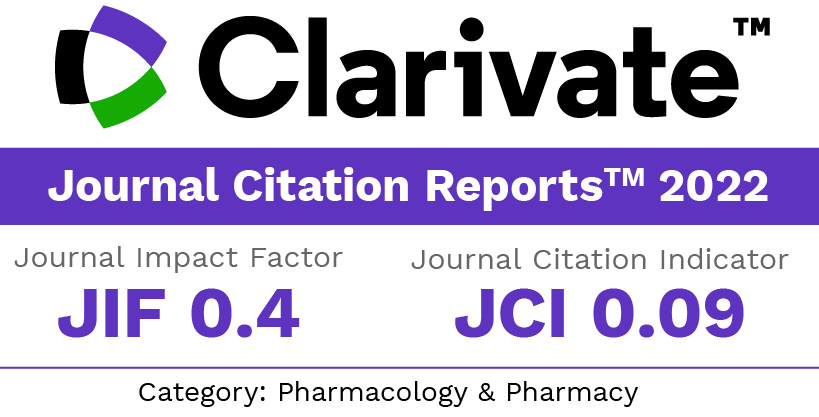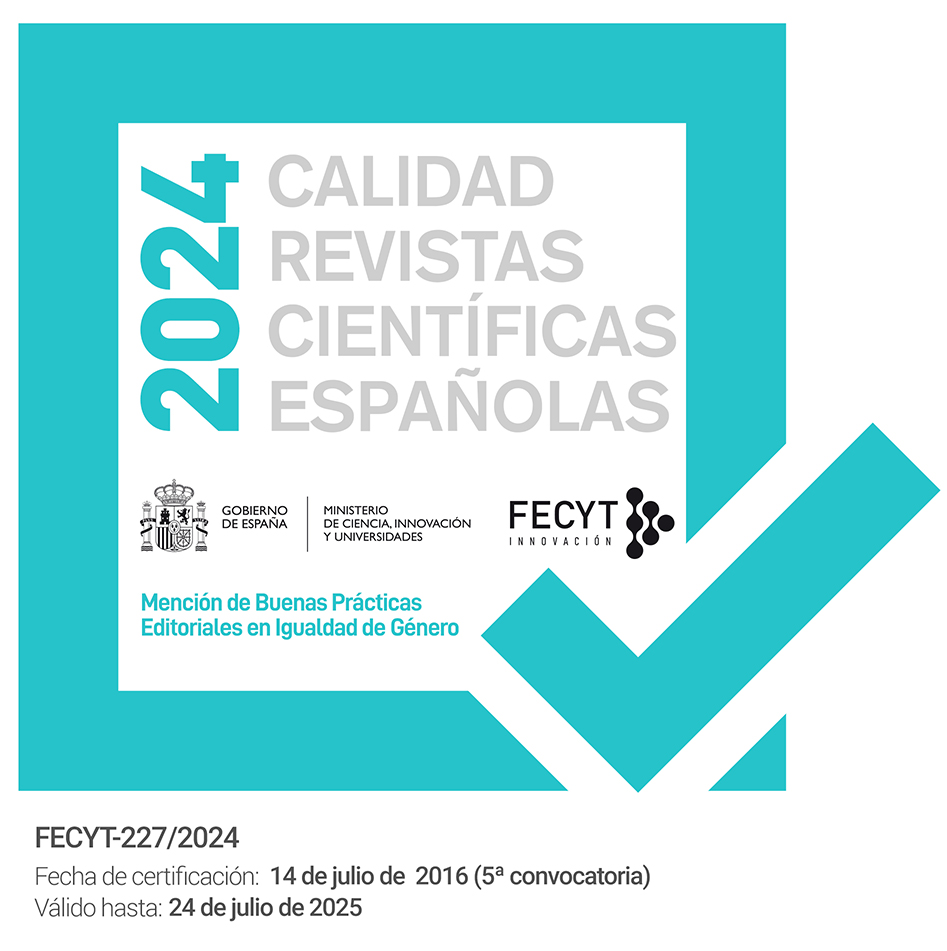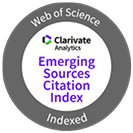Action Guide for the Community Pharmacist in Inflammatory Bowel Disease
DOI:
https://doi.org/10.30827/ars.v58i3.6529Keywords:
Pharmaceutical care, Inflammatory bowel disease, pharmacotherapeutic follow-upAbstract
Introduction: This guide is focused on helping the patient with Inflammatory Bowel Disease who attends the pharmacy office by offering pharmaceutical care services such as pharmacovigilance and pharmacotherapeutic follow-up that seek to promote the inclusion of the community pharmacist in the team of health.
Objective: To develop an action guide for the Community Pharmacist in patients with Inflammatory Bowel Disease
Methodology: The systematic review protocol for the development of this guide was developed based on the criteria in which they establish: Identify the research question, make a strategy plan in electronic databases, use a team approach to the extraction of information, perform a thematic analysis and summarize the information.
Results: The development of algorithms in this guide allows to provide timely information for the community pharmacist according to the individual characteristics presented in each patient, allowing the rapid and effective detection of problems that may arise during the illness in order to prevent and intervene timely.
Arguement: The information provided helps to strengthen the theoretical and practical knowledge of the community pharmacist, encouraging him to promote and promote pharmaceutical care services focused on the needs of the patient.
Downloads
References
Ondategui, S. Enfermedad Inflamatoria Intestinal: situación actual y retos asistenciales [Internet]. 2016 [Citado: 17 de Mayo de 2017] p 7-35. Disponible en: http://www.ey.com/Publication/vwLUAssets/EY-informe-enfermedad-inflamatoria-intestinal/$FILE/EY-enfermedad-inflamatoria-intestinal-situacion-actual-y-retos-asistenciales.pdf
“Inflammatory Bowel Disease: Epidemiology”, Datamonitor, 2012
Gómez A. E. Enfermedad inflamatoria intestinal. Terapia nutricional. Revista Nutrifarmacia [En línea]. Abril 2008. [Citado: 14 de Junio de 2017]; N° 4. Disponible en: http://www.elsevier.es/es-revista-farmacia-profesional-3-articulo-enfermedad-inflamatoria-intestinal-terapia-nutricional-13120121?referer=buscador
Ortigosa L. “Concepto actual y aspectos clínicos de la enfermedad de Crohn y la colitis ulcerosa”. Colombia medica PeoQuest ebary.web 2005; 36(2):16-24
Danese S, Sans M, Fiocchi C. “Inflammatory bowel disease: the role of environmental Factors”. Autoimmun Rev. 2004. N° 3: 394-400.
Arksey, H.; O’Malley, L.; Baldwin, S.; Harris, J.; Mason, A. Services to Support Carers of People with Mental Health Problems; National Health Service Delivery and Organization: London, UK, [Internet]. 2002 [Citado: 15 de Mayo de 2017]. Disponible en: http://eprints.whiterose.ac.uk/73297/1/Document.pdf
Arksey, H.; O’Malley, L. Scoping Studies: Towards a Methodological Framework. Int. J. Soc. Res. Methodol. [Internet]. 2005 [Citado: 15 de Mayo de 2017] 19–32. Disponible en: http://www.tandfonline.com/doi/abs/10.1080/1364557032000119616
Levac, D.; Colquhoun, H.; O’Brien, K.K. Scoping studies: Advancing the methodology. Implement. Sci. [Internet].2010 [Citado: 15 de Mayo de 2017] 5, 69. Disponible en: https://implementationscience.biomedcentral.com/articles/10.1186/1748-5908-5-69
Bonafont X, Bosch M, Martín A, Costa J. “Interacciones farmacológicas con los antibacterianos” [Internet], Cataluña 2011; [Citado: 14 de Mayo de 2017]; 22(8). Disponible en: http://www.cedimcat.info/images/bit/2010/esbit810.pdf
Gomollón F, García S, Sicilia B, Gisbertd J, Hinojosa J. “Guía clínica GETECCU del tratamiento de la colitis ulcerosa elaborada con la metodología GRADE”. Gastroenterol Hepatol. 2013; 36(8):1-47
Silverberg MS, Satsangi J, Ahmad T, Arnott ID, Bernstein CN, Brant SR, et al. “Towards an integrated clinical, molecular and serological classification of inflammatory bowel disease: Report of a working party of the 2005 Montreal World Congress of gastroenterology”. Can J Gastroenterol [Internet]. 2005 [Citado: 20 de Mayo de 2017];19(A:5):36. Disponible en: https://www.ncbi.nlm.nih.gov/pubmed/16151544
Lennard JE. “Classification of inflammatory bowel disease”. Scand J Gastroenterol Suppl 1989; 170: 2-6.
Ricart E. “Colitis ulcerosa” 2ª 2012, p 464-465. Disponible en: http://www.aegastro.es/sites/default/files/archivos/ayudas-practicas/32_Colitis_ulcerosa.pdf
Gassull MA, Gomollón F, Obrador A, Hinojosa J. Enfermedad inflamatoria intestinal. 2006; 1(3): 50-230
Garg SK, Ahuja V, Sankar M, Jeeva, Kumar A, Moss AC. “Curcumin for maintenance of remission in ulcerative colitis”. Cochrane Database of Systematic Reviews. [Internet] 2012. [Citado: 18 de Mayo de 2017]; N° 10. Disponible en: http://www.cochrane.org/CD008424/IBD_curcumin-for-maintenance-of-remission-in-ulcerative-colitis
De Ley M, De Vos R, Hommes DW, Stokkers PC. “Fish oil for induction of remission in ulcerative colitis”. Cochrane Database of Systematic Reviews [Internet] 2007, [Citado: 14 de Mayo de 2017] 4(1) 8-23. Disponible en: https://www.ncbi.nlm.nih.gov/pubmed/17943872
Mallon PT, McKay D, Kirk SJ, Gardiner K. “Probiotics for induction of remission in ulcerative colitis”. Cochrane Database of Systematic Reviews [Internet] 2007. [Citado: 14 de Mayo de 2017]. Vol 4. Disponible en: https://www.ncbi.nlm.nih.gov/pubmed/17943867
Naidoo K, Gordon M, Fagbemi AO, Thomas AG, Akobeng AK. “Probiotics for maintenance of remission in ulcerative colitis”. Cochrane Database of Systematic Reviews [Internet] 2011, [Citado: 14 de Mayo de 2017] 7(12). Disponible en: https://www.ncbi.nlm.nih.gov/pubmed/22161412
Pillai A, Nelson RL. “Probiotics for treatment of Clostridium difficile-associated colitis in adults”. Cochrane Database of Systematic Reviews [Internet] 2008 [Citado: 14 de Mayo de 2017] 23(1). Disponible en: https://www.ncbi.nlm.nih.gov/pubmed/18254055
Akhtar MS, Munir M. "Evaluación de los gástricas: efectos anti-ulcerogénicos de Solanum nigrum, Brassica oleracea y Ocimum basilicum en ratas". Revista de Etnofarmacología. 27 (1-2): 163-76.
Del Pinto R, Pietropaoli D, Chandar AK, Ferri C, Cominelli F. "Relación Entre la enfermedad inflamatoria intestinal y deficiencia de vitamina D: Una Revisión Sistemática y meta-análisis" Las diseases inflamatorias intestinales. 2015 [Citado: 14 de Mayo de 2017]; 21 (11)
Brzezinski A, Rankin GB, Seidner DL, Lashner BA. "El uso de Formulaciones de ácido 5-aminosalicílico orales antiguos y Nuevos en la enfermedad inflamatoria intestinal". Cleveland Clinic Journal of Medicine. 1995; 62 (5):317-23.
Salim AS "El papel de Agentes Que contienen sulfhidrilo-en la gestión de los Ataques recurrentes de la colitis ulcerosa. Un nuevo Enfoque". Farmacología. 1992; 45 (6): 307-18.
Brzezinski A, Rankin GB, Seidner DL, Lashner BA. "El Uso de Formulaciones de ácido 5-aminosalicílico orales antiguos y Nuevos en la enfermedad inflamatoria intestinal". Cleveland Clinic Journal of Medicine. 1995; 62 (5): 317-23.
Salim AS (1992). "El papel de Agentes Que contienen sulfhidrilo-en la gestión de los Ataques recurrentes de la colitis ulcerosa. Un nuevo Enfoque". Farmacología . 45 (6): 307-18.Disponible en: 10.1159/00139016 .PMID 1.362.613
Castillo D, Rosas J.V, Serrano A, Amezcua L.M. “Enfermedad Inflamatoria Intestinal”. Revista de Especialidades Médico-Quirúrgicas [Internet] 2005 [Citado: 14 de Mayo de 2017] 10(2). Disponible en: http://www.medigraphic.com/pdfs/quirurgicas/rmq-2005/rmq052c.pdf
Sistema Nacional de Salud. “Nuevos principios activos”. [Internet]; 2010 [Citado: 18 de Mayo de 2017]; 34(3). Disponible en: http://www.msssi.gob.es/biblioPublic/publicaciones/recursos_propios/infMedic/docs/vol34n3CertolizumabEstiripentol.pdf
Chartier FL, Bossu JP, Laudet V, Fruchart JC, Laine B. “Cloning and sequencing of cDNAs encoding the human hepatocyte nuclear factor 4 indicate the presence of two isoforms in human liver”. Gene. [Internet]. 1994 [Citado: 19 de Mayo de 2017]; 147 (2): 269-72. Disponible en:10.1016/0378-1119(94)90079-5. PMID 7926813
Argyrokastritis A, Kamakari S, Kapsetaki M, Kritis A, Talianidis I, Moschonas NK. “Human hepatocyte nuclear factor-4 (hHNF-4) gene maps to 20q12-q13.1 between PLCG1 and D20S17” Hum. Genet. [Internet] 1997 [Citado: 19 de mayo de 2017]; 99 (2): 233-6. Disponible en: https://www.ncbi.nlm.nih.gov/pubmed?cmd=link&linkname=pubmed_pubmed&uid=8938460
Semb H, Christofori G. “The tumor-suppressor function of E-cadherin”. Am. J. Hum. Genet. 1998; 63 (6): 1588-93.
Wong AS, Gumbiner BM. “Adhesion-independent mechanism for suppression of tumor cell invasion by E-cadherin”. J. Cell Biol [Internet]. 2003 [Citado: 21 de Mayo de 2017]; 161 (6): 1191-203. Disponible en: http://jcb.rupress.org/content/161/6/1191/tab-pdf
Bonneau D, Huret JL, Godeau G, Couet D, Putterman M, Tanzer J, et al. "Recurrent ctb(7)(q31.3) and possible laminin involvement in a neonatal cutis laxa with a Marfan phenotype". Hum Genet. 1991; 87 (3): 317–9.
Turner CA, Mack DH, Davis MM. "Blimp-1, a novel zinc finger-containing protein that can drive the maturation of B lymphocytes into immunoglobulin-secreting cells". Cell. 1994; 77 (2): 297–306.
Machuca M, Fernández-Llimós F, Faus MJ. Guía de seguimiento farmacoterapéutico. Granada: GIAF-UGR, 189-194.
Fernández-Llimós F, Faus MJ, Gastelurrutia MA, Baena MI, Martinez Martinez F. Evolución del concepto de problemas relacionados con medicamentos: resultados como el centro del nuevo paradigma. 2005; 3(4) 167-188.
Downloads
Published
How to Cite
Issue
Section
License
The articles, which are published in this journal, are subject to the following terms in relation to the rights of patrimonial or exploitation:
- The authors will keep their copyright and guarantee to the journal the right of first publication of their work, which will be distributed with a Creative Commons BY-NC-SA 4.0 license that allows third parties to reuse the work whenever its author, quote the original source and do not make commercial use of it.
b. The authors may adopt other non-exclusive licensing agreements for the distribution of the published version of the work (e.g., deposit it in an institutional telematic file or publish it in a monographic volume) provided that the original source of its publication is indicated.
c. Authors are allowed and advised to disseminate their work through the Internet (e.g. in institutional repositories or on their website) before and during the submission process, which can produce interesting exchanges and increase citations of the published work. (See The effect of open access).























